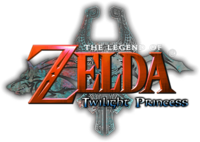Twilight Princess features a stylized, naturalistic art style (similar to, but more advanced than, that found in Ocarina of Time), rather than the cel-shaded look that The Wind Waker exhibited — although it still makes use of cel-shading effects, using a very heavily modified version of The Wind Waker’s engine. In a further departure from The Wind Waker, Link is once again a young man, as opposed to a child, as in the latter part of Ocarina of Time, Link's Awakening, A Link to the Past, and in The Adventure of Link. The game also takes on a darker tone, rivaling that of Majora's Mask.
Link transforms into a wolf when entering the Twilight Realm, a void that has ensnared Hyrule. This is not a wholly separate place like the Dark World in A Link to the Past, but an evil transformation that slowly spreads across Hyrule.
There are three versions of Twilight Princess: Wii, GameCube, and Wii U.
Wii[edit | edit source]
This version was released on November 19, 2006, about a month before the GameCube release. In this version, the whole world was flipped to make Link right-handed, since most players are right-handed. The Wii version uses the "point-and-click" of the ![]() as a "fairy" cursor, for accessing menus, and for using various tools such as the Hero's Bow, Clawshot, and Fishing Rod; it uses
as a "fairy" cursor, for accessing menus, and for using various tools such as the Hero's Bow, Clawshot, and Fishing Rod; it uses ![]() on the
on the ![]() for movement. In order to swing the sword, the player makes a slashing motion with
for movement. In order to swing the sword, the player makes a slashing motion with ![]() . A jab with the tilt-sensitive
. A jab with the tilt-sensitive ![]() will cause Link to perform one of his secret moves, the shield attack. To use Link’s "spin attack", the player swings
will cause Link to perform one of his secret moves, the shield attack. To use Link’s "spin attack", the player swings ![]() horizontally.
horizontally.
GameCube[edit | edit source]
The GameCube version uses a control scheme similar to The Legend of Zelda: The Wind Waker. This version of Twilight Princess features a left-handed Link, similar to all the other Zelda games except for Skyward Sword. The storyline and gameplay is identical between the Wii and GameCube version (with the exception of the east-west swap). The item layout in the GameCube version are almost the same as the Wind Waker, except ![]() uses Midna and there are only two item slots (
uses Midna and there are only two item slots (![]() ,
, ![]() ). Lastly this is the only version which doesn't have widescreen support, instead uses letterbox to makeup for its lack of option.
). Lastly this is the only version which doesn't have widescreen support, instead uses letterbox to makeup for its lack of option.
Wii U[edit | edit source]
The "HD" version will feature a hybrid of both Gamecube and Wii giving a similar resonance to "Ocarina of Time 3D". Even though it uses the "Gamecube" mode with Link as left handed as a default mode, the "Wii" mode has Link as right handed but the difficulty raised to Hero mode. It also comes with additional features that's not part of the Gamecube/Wii version. Apart from the high end graphics and widescreen that's not available on Gamecube. Also note some subtle text changes from 10 years ago.
Other notes[edit | edit source]
In Twilight Princess, Link learns more moves than in any other Legend of Zelda game to date. Link also shares similar moves between human and wolf, for example when an enemy is on the ground, Link has the option to finish them off by plunging his sword into their chest or in wolf form (on poes, to rip out their souls). Link can communicate with animals in wolf form as if they were people. When transformed into a wolf, Link’s sense of smell is greatly improved.
With these abilities come some disadvantages. While he is a wolf, Link cannot utilize any of his items, or open any doors with handles until he can transform into a human. Worst of all he can not change without being seen by humans that might cause an uproar. So leaving the area is the only way you can transform without causing further trouble.
There is no extensive voice acting in the game. The characters laugh, scream, and make other such noises, as they have in previous installments on the Nintendo 64 and Nintendo GameCube. However, in Twilight Princess, the characters' mouths move with the text, simulating speech without actual sound. Lastly the voice for Midna differs between the Wii and Gamecube versions.
